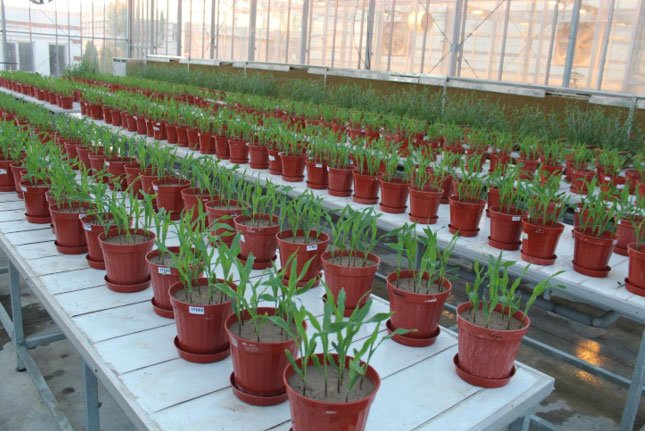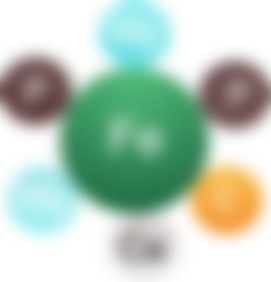Effect of Nutrients on physiology of plants.....

27, May 2022
The field of plant physiology includes the study of all the internal activities of plants those chemical and physical processes associated with life as they occur in plants. ... At the largest scale are the processes of plant development, seasonality, dormancy, and reproductive control. Plants growth and development largely depend on the combination and concentration of mineral nutrients available in the soil.
Plants often face significant challenges in obtaining an adequate supply of these nutrients to meet the demands of basic cellular processes due to their relative immobility.
A deficiency of any one of them may result in decreased plant productivity and/or fertility. Symptoms of nutrient deficiency may include stunted growth, death of plant tissue, or yellowing of the leaves caused by a reduced production of chlorophyll, a pigment needed for photosynthesis.
Nutrient deficiency can have a significant impact on agriculture, resulting in reduced crop yield or reduced plant quality. Nutrient deficiency can also lead to reduced overall biodiversity since plants serve as the producers that support most food webs.
Two classes of nutrients are considered essential for plants:
Macro-nutrients and Micro-nutrients.

Macronutrients are the building blocks of crucial cellular components like proteins and nucleic acids; as the name suggests, they are required in large quantities. Nitrogen, phosphorus, magnesium, and potassium are some of the most important macronutrients.
Carbon, hydrogen, and oxygen are also considered macronutrients as they are required in large quantities to build the larger organic molecules of the cell; however, they represent the non-mineral class of macronutrients.
Micronutrients, including iron, zinc, manganese, and copper, are required in very small amounts. Micronutrients are often required as cofactors for enzyme activity.Mineral nutrients are usually obtained from the soil through plant roots, but many factors can affect the efficiency of nutrient acquisition. First, the chemistry and composition of certain soils can make it harder for plants to absorb nutrients.
The nutrients may not be available in certain soils, or may be present in forms that the plants cannot use. Soil properties like water content, pH, and compaction may exacerbate these problems.
Second, some plants possess mechanisms or structural features that provide advantages when growing in certain types of nutrient limited soils. In fact, most plants have evolved nutrient uptake mechanisms that are adapted to their native soils and are initiated in an attempt to overcome nutrient limitations.
One of the most universal adaptations to nutrient-limited soils is a change in root structure that may increase the overall surface area of the root to increase nutrient acquisition or may increase elongation of the root system to access new nutrient sources. These changes can lead to an increase in the allocation of resources to overall root growth, thus resulting in greater root to shoot ratios in nutrient-limited plants.

Plants are known to show different responses to different specific nutrient deficiencies and the responses can vary between species. The most common changes are inhibition of primary root growth (often associated with P deficiency), increase in lateral root growth and density (often associated with N, P, Fe, and S deficiency) and increase in root hair growth and density (often associated with P and Fe deficiency). While nutrient deficiencies can pose serious threats to plant productivity, nutrients can become toxic in excess, which is also problematic.
When some micro nutrients accumulate to very high levels in plants, they contribute to the generation of reactive oxygen species (ROS), which can cause extensive cellular damage.
Some highly toxic elements like lead and cadmium cannot be distinguished from essential nutrients by the nutrient uptake systems in the plant root, which means that in contaminated soils, toxic elements may enter the food web via these nutrient uptake systems, causing reduced uptake of the essential nutrient and significantly reduced plant growth and quality. In order to maintain nutrient homeostasis, plants must regulate nutrient uptake and must respond to changes in the soil as well as within the plant.
Thus, plant species utilize various strategies for mobilization and uptake of nutrients as well as chelation, transport between the various cells and organs of the plant and storage to achieve whole-plant nutrient homeostasis.
Here, we briefly describe a few examples of strategies used by plants to acquire nutrients from the soil.
Overview of root architecture changes in response to nutrients deficiency
Plant Acquisition of nutrients:
Potassium (K) is considered a macronutrient for plants and is the most abundant cation within plant cells. Potassium has a number of important functions within plants, including balancing the charges of cellular anions, enzyme activation, control of stomatal opening/closing.
Potassium deficiency occurs frequently in plants grown on sandy soils resulting in a number of symptoms including browning of leaves, curling of leaf tips and yellowing (chlorosis) of leaves, as well as reduced growth and fertility.
Iron is essential for plant growth and development and is required as a cofactor for proteins that are involved in a number of important metabolic processes including photosynthesis and respiration. Despite the fact that iron is the fourth most abundant element in the earth's crust, it is often limiting for plants due to the fact that it tends to form insoluble complexes in aerobic soils of neutral to basic pH .
It is thought that iron limitation is a problem for plants on as much as 30% of soils worldwide.
Iron-deficient plants often display interveinal chlorosis, in which the veins of the leaf remain green while the areas between the veins are yellow. Nitrogen and phosphorus are among the elements considered most limiting to plant growth and productivity because they are often present in small quantities locally or are present in a form that cannot be used by the plant.
As a result, the evolution of many plant species has included the development of mutually beneficial symbiotic relationships with soil-borne microorganisms.
In these relationships, both the host plant and the microorganism symbiont derive valuable resources that they need for their own productivity and survival as a result of the association.
Despite the fact that nitrogen is the most abundant gaseous element in the atmosphere, plants are unable to utilize the element in this form (N2) and may experience nitrogen deficiency in some soils that have low nitrogen content.
Since nitrogen is a primary component of both proteins and nucleic acids, nitrogen deficiency imposes significant limitations to plant productivity.
In an agricultural setting, nitrogen deficiency can be combated by the addition of nitrogen-rich fertilizers to increase the availability of nutrients and thereby increase crop yield.
However, this can be a dangerous practice since excess nutrients generally end up in ground water, leading to eutrophication and subsequent oxygen deprivation of connected aquatic ecosystems.
Plants are able to directly acquire nitrate and ammonium from the soil. However, when these nitrogen sources are not available, certain species of plants from the family Fabaceae (legumes) initiate symbiotic relationships with a group of nitrogen fixing bacteria called Rhizobia.

These interactions are relatively specific and require that the host plant and the microbe recognize each other using chemical signals. The interaction begins when the plant releases compounds called flavonoids into the soil that attract the bacteria to the roots.In addition to symbiotic relationships with bacteria, plants can participate in symbiotic associations with fungal organisms as well.
Current estimates of the frequency of plant-mycorrhizal associations suggest that around 80% of all plants establish some type of mycorrhizal symbiosis, and many studies indicate that these relationships are millions of years old (Karandashov & Bucher, 2005; Vance, 2001). There are several classes of mycorrhiza, differing in structural morphology, the method of colonizing plant tissue, and the host plants colonized.
However, there are two main classes that are generally regarded as the most common and therefore, the most ecologically significant.
The endo-mycorrhizae are those fungi that establish associations with host plants by penetrating the cell wall of cortical cells in the plant roots.
By contrast, ecto-mycorrhizae develop a vast hyphae network between cortical cells but do not actually penetrate the cells.
Plant growth and development largely depend on the combination and concentration of mineral nutrients available in the soil. ...
Symptoms of nutrient deficiency
These may include stunted growth, death of plant tissue, or yellowing of the leaves caused by a reduced production of chlorophyll, a pigment needed for photosynthesis.
Conclusion:
Although plants are non-motile and often face nutrient shortages in their environment, they utilize a plethora of sophisticated mechanisms in an attempt to acquire sufficient amounts of the macro- and micronutrients required for proper growth, development and reproduction.
These mechanisms include changes in the developmental program and root structure to better "mine" the soil for limiting nutrients, induction of high affinity transport systems and the establishment of symbioses and associations that facilitate nutrient uptake.
Together, these mechanisms allow plants to maximize their nutrient acquisition abilities while protecting against the accumulation of excess nutrients, which can be toxic to the plant. It is clear that the ability of plants to utilize such mechanisms exerts significant influence over crop yields as well as plant community structure, soil ecology, ecosystem health, and biodiversity.


